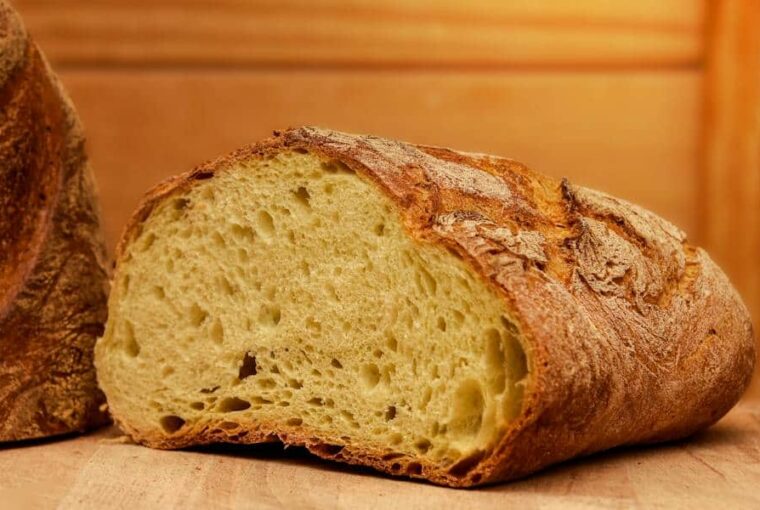Dietary preferences and health-conscious choices have led many individuals to scrutinize their food options more closely, including their bread choices. Rye bread, known for its distinct flavor and nutritional benefits, has garnered significant attention. However, amidst the growing demand for gluten-free options, a fundamental question arises: Is rye bread gluten-free? This comprehensive guide will delve into the intricacies of rye bread and gluten and the various factors determining whether individuals with gluten sensitivities or celiac disease can safely consume this beloved bread.
Is Rye Bread Gluten-Free?
No, rye bread is not gluten-free. Rye is a grain that contains gluten, a protein responsible for the elasticity and texture of bread. Therefore, rye bread is unsuitable for gluten sensitivities or celiac disease individuals. If you’re looking for gluten-free alternatives, you must explore options made from gluten-free grains like rice, corn, or certified gluten-free oats.
The Nutritional Composition Of Rye Bread
Rye bread is renowned for its distinct flavor and impressive nutritional composition, which sets it apart from many other types of bread. Let’s delve deeper into the nutritional profile of rye bread, focusing on its fiber content, vitamins, and minerals.
Fiber: Rye bread is a dietary fiber powerhouse. It contains significantly more fiber than traditional white wheat bread. A single slice of rye bread can provide approximately 1-2 grams of dietary fiber, depending on the brand and type. This high fiber content improves digestive health, aids regular bowel movements, and helps regulate blood sugar levels. It also contributes to a feeling of fullness, which can benefit weight management.
Vitamins: Rye bread is a good source of several essential vitamins. It’s vibrant in B vitamins, including thiamin (B1), riboflavin (B2), niacin (B3), and folate (B9). These vitamins are critical for various bodily functions, such as energy metabolism, cell growth, and the formation of red blood cells. Rye bread can be an important part of a balanced diet for individuals seeking to meet their daily B-vitamin requirements.
Minerals: Rye bread contains various essential minerals that contribute to overall health. Notable minerals in rye bread include iron, magnesium, phosphorus, and zinc. Iron is essential for oxygen transport in the blood and the prevention of anemia. Magnesium and phosphorus are crucial for bone health, nerve function, and muscle contraction, while zinc plays a role in immune function and wound healing.
Antioxidants: Rye bread also contains antioxidants, such as lignans. These compounds have been associated with potential health benefits, including reduced risk of heart disease and certain types of cancer. Antioxidants help combat harmful free radicals in the body, contributing to overall well-being.
Protein: Rye bread offers a moderate protein content, vital in supporting muscle maintenance, bolstering the immune system, and facilitating the repair and regeneration of body tissues when needed.
Low In Fat: Rye bread tends to have a lower fat content when compared to certain other types of bread, which positions it as a heart-healthy option for individuals seeking bread with reduced fat levels.
Explain The Potential Health Benefits Of Consuming Rye Bread
Because of its unique nutritional composition and fiber-rich nature, consuming rye bread can offer a range of potential health benefits. Here are some of the critical health benefits associated with including rye bread in your diet:
Rye bread is an excellent dietary fiber source, promoting regular bowel movements and helping prevent constipation. The fiber in rye bread can also support a healthy gut microbiome by serving as food for beneficial gut bacteria. This, in turn, can contribute to improved overall digestive health.
The high fiber content in rye bread slows digestion and absorption of carbohydrates, leading to a more gradual and steady release of glucose into the bloodstream. This can help regulate blood sugar levels, making rye bread a favorable choice for individuals with diabetes or those concerned about blood sugar spikes.
Rye bread is associated with a reduced risk of heart disease. Its fiber content helps lower LDL (bad) cholesterol levels, which benefits heart health. Additionally, rye bread contains antioxidants, such as lignans, linked to lower blood pressure and improved cardiovascular function.
The fiber in rye bread promotes a feeling of fullness and satiety, which can help control appetite and reduce overall calorie intake. This makes it a valuable addition to weight management and weight loss diets.
Some studies suggest that a diet rich in whole grains, like those found in rye bread, may lower the risk of developing colon cancer. The fiber and antioxidants in rye bread may play a role in this protective effect.
Rye bread is a good source of various vitamins and minerals, including B vitamins (thiamin, riboflavin, niacin, and folate), iron, magnesium, phosphorus, and zinc. These nutrients are essential for various bodily functions and overall well-being.
Regularly consuming whole grains, like rye bread, has been associated with a lower risk of developing type 2 diabetes. The fiber and nutrients in rye bread contribute to better insulin sensitivity and improved glucose metabolism.
The Role Of Gluten In Bread And Its Impact On Health
Gluten is a protein in various grains, including wheat, barley, and rye. It plays a crucial role in bread-making due to its unique properties. Here’s an explanation of the role of gluten in bread and its impact on health:
Role Of Gluten In Bread:
- Structural Support: Gluten provides bread with its characteristic structure and texture. When flour is mixed with water and kneaded, gluten proteins form a network of interconnected strands. This network traps carbon dioxide gas produced by yeast or other leavening agents, causing the dough to rise and giving the bread its airy, elastic structure.
- Dough Elasticity: Gluten gives dough its elasticity, allowing it to stretch and expand without breaking. This property is essential for shaping and forming bread and achieving the desired crumb structure (the interior texture of the bread).
- Gas Retention: The gluten network is a barrier to prevent gas from escaping the dough during fermentation and baking. This trapped gas results in the characteristic rise and lightness of bread.
Impact Of Gluten On Health:
- Celiac Disease: For individuals with celiac disease, consuming gluten can have severe health consequences. Celiac disease is an autoimmune disorder in which the ingestion of gluten triggers an immune response that damages the lining of the small intestine. This can lead to malabsorption of nutrients, digestive issues, and other health problems. People with celiac disease must strictly avoid gluten-containing foods, including most traditional bread.
- Non-Celiac Gluten Sensitivity: Some individuals experience symptoms similar to those of celiac disease when consuming gluten but do not have the autoimmune response or intestinal damage seen in celiac disease. This condition is known as non-celiac gluten sensitivity (NCGS). The exact mechanisms behind NCGS are poorly understood, but it can lead to gastrointestinal discomfort, headaches, fatigue, and other symptoms. Avoiding gluten-containing foods, including bread, can alleviate these symptoms for NCGS patients.
- Wheat Allergy: A wheat allergy is distinct from celiac disease or NCGS. It is an allergic reaction to proteins found in wheat, including gluten. Consuming wheat-containing products, such as bread, can trigger symptoms ranging from mild hives to severe anaphylaxis in individuals with a wheat allergy. Avoiding wheat-based foods, including most bread, is necessary for those with a wheat allergy.
- Gluten-Free Diet Trend: Beyond individuals with specific medical conditions, some people follow a gluten-free diet as a lifestyle choice. This trend has led to a wide variety of gluten-free bread and food options available in the market.
Tips On Preparing Gluten-Free Rye Bread At Home
Preparing gluten-free rye bread at home can be rewarding, especially for individuals who have gluten sensitivities or celiac disease but still crave the flavors of traditional rye bread. Here are some tips to help you successfully make gluten-free rye bread:
Use Gluten-Free Flour:
The most critical aspect of gluten-free baking is choosing the right flour blend. Look for gluten-free flour mixes specifically designed for bread baking. These blends typically combine gluten-free flour and starches, such as rice flour, tapioca, and potato starch. Some gluten-free flours mimic the texture and properties of gluten-containing flours, which is crucial for rye bread.
Incorporate Rye Flavor:
While you won’t use traditional rye flour (since it contains gluten), you can still achieve rye flavor by using ingredients like rye flavoring or rye extract. These additives help capture the distinctive taste associated with rye bread.
Add Xanthan Gum Or Guar Gum:
Gluten-free flours lack the binding properties of gluten, so adding a binder like xanthan gum or guar gum can help improve the texture and structure of your bread. Follow the recommended ratios on the flour mix or recipe you’re using.
Include High-Fiber Ingredients:
To replicate the fiber content of traditional rye bread, consider adding high-fiber ingredients like ground flaxseeds, chia seeds, or psyllium husk. These ingredients also contribute to moisture retention and overall texture.
Hydrate The Dough:
Gluten-free dough tends to be stickier and wetter than traditional dough. Don’t be alarmed by this; it’s normal. Use wet hands or utensils to work with the dough, and consider using parchment paper or a well-greased bread pan to shape and bake the bread.
Allow Proper Rising Time:
Gluten-free dough may require a longer rise than wheat-based dough. Be patient and allow the dough to rise until it reaches the desired volume. This helps develop the bread’s structure and texture.
Conclusion
Gluten-free rye bread, though a departure from its traditional counterpart, can still be a delightful and nutritious addition to your diet. Understanding the intricacies of gluten’s role in bread and its impact on health is essential, particularly for individuals with gluten sensitivities or celiac disease. For those who require or prefer gluten-free options, homemade gluten-free rye bread offers a satisfying solution, provided you choose the suitable flour blends, incorporate rye flavor, and master the art of gluten-free baking. While it may take some experimentation to achieve the perfect gluten-free rye bread, the potential health benefits are numerous. You can enjoy improved digestive health, better blood sugar control, reduced risk of heart disease, and more stable energy levels while relishing rye’s unique flavor.




